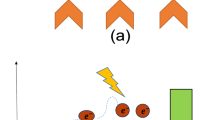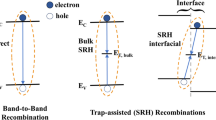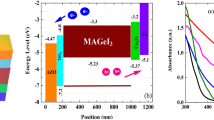Abstract
Perovskite single crystals have received enormous attention in recent years. This is, perhaps, due to their simplistic synthesis and excellent optoelectronic properties including the long carrier diffusion length, high carrier mobility, low trap density, and tuneable absorption edge ranging from ultra-violet to near-infrared. These distinguishing features offer numerous potential applications in energy-related fields like solar cells, photodetectors, lasers, etc. Efficiency enhancement and stability, in general, are the main challenges to obtaining better solar cells. One of the main reasons for the early degradation of solar cells is heat generation due to high energy electrons and holes in the conduction and valance bands. In this study, the authors try to introduce the concept of selective energy contacts in perovskite solar cells. Also, they investigate how this concept affects the power conversion efficiency (enhancement) and heat generation due to hot electrons and holes (reduction) scattering in the conduction and valance bands. Both efficiency enhancement and reduction in heat generation have been calculated in this study. Thus, for mathematical modeling of the anticipated idea, the Methylammonium lead halide (CH3NH3PbI3) material is used in a PIN structure for a single-junction solar cell. Also, for the proposed structure, analytical modeling was introduced and it is shown that the efficiency of a single contact cell is around 25%, and after applying the second contact, the efficiency was increased to 35%. Finally, due to the reduction of heat loss in the structure, the stability of perovskite material is significantly increased.





Similar content being viewed by others
References
Bella, F., Renzi, P., Cavallo, C., Gerbaldi, C.: Caesium for perovskite solar cells: an overview. Chem. Eur. J. 24, 12183–12205 (2018)
Burschka, J., Pellet, N., Moon, S.-J., Humphry-Baker, R., Gao, P., Nazeeruddin, M.K., Grätzel, M.: Sequential deposition as a route to high-performance perovskite-sensitized solar cells. Nature 499, 316–319 (2013)
Ding, J., Du, S., Zhou, T., Yuan, Y., Cheng, X., Jing, L., Yao, Q., Zhang, J., He, Q., Cui, H., Zhan, X., Sun, H.: Cesium decreases defect density and enhances optoelectronic properties of mixed MA1–xCsxPbBr 3 single crystal. J. Phys. Chem. C. 123, 14969–14975 (2019)
Dong, Q., Fang, Y., Shao, Y., Mulligan, P., Qiu, J., Cao, L., Huang, J.: Solar cells electron-hole diffusion lengths > 175 mum in solution-grown CH3NH3PbI3 single crystals. Science 347, 967–970 (2015)
Du, H.J., Wang, W.C., Gu, Y.F.: Simulation design of P-I-N-type all-perovskite solar cells with high efficiency. Chin. Phys. B 26, 1–7 (2017)
Hao, F., Stoumpos, C.C., Cao, D.H., Chang, R.P.H., Kanatzidis, M.G.: Lead-free solid-state organic-inorganic halide perovskite solar cells. Nat. Photon. 8, 489–494 (2014a)
Hao, F., Stoumpos, C.C., Chang, R.P.H., Kanatzidis, M.G.: Anomalous band gap behavior in mixed Sn and Pb perovskites enables broadening of absorption spectrum in solar cells. J. Am. Chem. Soc. 136, 8094–8099 (2014b)
Heo, J.H., Im, S.H., Noh, J.H., Mandal, T.N., Lim, C., Chang, J.A., Lee, Y.H., Kim, H., Sarkar, A., Nazeeruddin, M.K., Graetzel, M., Seok, S.I.: Efficient inorganic–organic hybrid heterojunction solar cells containing perovskite compound and polymeric hole conductors. Nat. Photon. 7, 486–491 (2013)
Hou, M., Xu, Y., Tian, Y., Wu, Y., Zhang, D., Wang, G., Li, B., Ren, H., Li, Y., Huang, Q., Ding, Y., Hou, G., Zhao, Y., Zhang, X.: Synergistic effect of MACl and DMF towards efficient perovskite solar cells. Org. Electron. 88, 1–9 (2021)
Huang, T., Tan, S., Nuryyeva, S., Yavuz, I., Babbe, F., Zhao, Y., Abdelsamie, M., Weber, M.H., Wang, R., Houk, K.N., Sutter-Fella, C.M., Yang, Y.: Performance-limiting formation dynamics in mixed-halide perovskites. Sci. Adv. 1–9 (2021). https://doi.org/10.1126/sciadv.abj1799
Kim, H.-S., Lee, C.-R., Im, J.-H., Lee, K.-B., Moehl, T., Marchioro, A., Moon, S.-J., Humphry-Baker, R., Yum, J.-H., Moser, J.E., Grätzel, M., Park, N.-G.: Lead iodide perovskite sensitized all-solid-state submicron thin film mesoscopic solar cell with efficiency exceeding 9%. Sci. Rep. 2, 1–7 (2012)
Koh, T.M., Fu, K., Fang, Y., Chen, S., Sum, T.C., Mathews, N., Mhaisalkar, S.G., Boix, P.P., Baikie, T.: Formamidinium-containing metal-halide: an alternative material for near-IR absorption perovskite solar cells. J. Phys. Chem. C 118, 16458–16462 (2014)
Kojima, A., Teshima, K., Shirai, Y., Miyasaka, T.: Organometal halide perovskites as visible-light sensitizers for photovoltaic cells. J. Am. Chem. Soc. 131, 6050–6051 (2009)
Lee, M.M., Teuscher, J., Miyasaka, T., Murakami, T.N., Snaith, H.J.: Efficient hybrid solar cells based on meso-superstructured organometal halide perovskites. Science 338, 643–647 (2012)
Li, W., Wang, H., Hu, X., Cai, W., Zhang, C., Wang, M., Zang, Z.: Sodium benzenesulfonate modified poly (3,4-Ethylenedioxythiophene): polystyrene sulfonate with improved wettability and work function for efficient and stable perovskite solar cells. Solar RRL 5(1), 1–25 (2020)
Li, Y., Wu, H., Qi, W., Zhou, X., Li, J., Cheng, J., Zhao, Y., Li, Y., Zhang, X.: Passivation of defects in perovskite solar cell: From a chemistry point of view. Nano Energy 77, 1–24 (2020)
Liu, M., Johnston, M.B., Snaith, H.J.J.N.: Efficient planar heterojunction perovskite solar cells by vapor deposition. Nature 501, 395–398 (2013)
National Renewable Energy Laboratory, Best research-cell efciencies,2019,www.nrel.gov/pv/assets/pdfs/pv-efciencychart. 20190103
Niu, G., et al.: Enhancement of thermal stability for perovskite solar cells through cesium doping. RSC Adv. 7(28), 17473–17479 (2017)
Shayan, S., Matloub, S., Rostami, A.: Efficiency enhancement in a single bandgap silicon solar cell considering hot-carrier extraction using selective energy contacts. Opt. Express 29(4), 5068–5080 (2021)
Stranks, S.D., Eperon, G.E., Grancini, G., Menelaou, C., Alcocer, M.J.P., Leijtens, T., Herz, L.M., Petrozza, A., Snaith, H.J.: Electron-hole diffusion lengths exceeding 1 micrometer in an organometal trihalide perovskite absorber. Science 342, 341–344 (2013)
Todorov, T., Gunawan, O., Guha, S.: A road towards 25% efficiency and beyond: perovskite tandem solar cells. Mol. Syst. Des. Eng. 1(4), 370–376 (2016)
Xiao, J.W., Liu, L., Zhang, D., De Marco, N., Lee, J.W., Lin, O., Chen, Q., Yang, Y.: The emergence of the mixed perovskites and their applications as solar cells. Adv. Energy Mater. 7, 1–20 (2017)
Xing, G., Mathews, N., Sun, S., Lim, S.S., Lam, Y.M., Graetzel, M., Mhaisalkar, S., Sum, T.C.: Long-range balanced electron-and hole-transport lengths in organic-inorganic CH3NH3PbI3. Science 342, 344–347 (2013)
Yang, W.S., Park, B.W., Jung, E.H., Jeon, N.J., Kim, Y.C., Lee, D.K., Shin, S.S., Seo, J., Kim, E.K., Noh, J.H., Seok, S.: Iodide management in formamidinium-lead-halide–based perovskite layers for efficient solar cells. Science 356, 1376–1379 (2017)
Yang, Z., Yu, Z., Wei, H., Xiao, X., Ni, Z., Chen, B., Deng, Y., Habisreutinger, S.N., Chen, X., Wang, K.: Enhancing electron diffusion length in narrow-bandgap perovskites for efficient monolithic perovskite tandem solar cells. Nat. Commun. 10, 1–9 (2019)
Zhou, T., Wang, M., Zang, Z., Fang, L.: Stable dynamics performance and high efficiency of ABX3-type super-alkali perovskites first obtained by introducing H5O2 cation. Adv. Energy Mater. 9, 1–9 (2019)
Funding
The authors have not disclosed any funding.
Author information
Authors and Affiliations
Corresponding author
Ethics declarations
Conflict of interest
The authors have not disclosed any competing interests.
Additional information
Publisher's Note
Springer Nature remains neutral with regard to jurisdictional claims in published maps and institutional affiliations.
Rights and permissions
About this article
Cite this article
Rostami, A., Tofigi, I., Barzinjy, A.A. et al. Theoretical modelling of high-efficiency perovskite solar cells and reduction of internal heat generation using hot-electron extraction. Opt Quant Electron 54, 234 (2022). https://doi.org/10.1007/s11082-022-03618-7
Received:
Accepted:
Published:
DOI: https://doi.org/10.1007/s11082-022-03618-7




